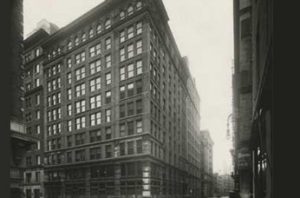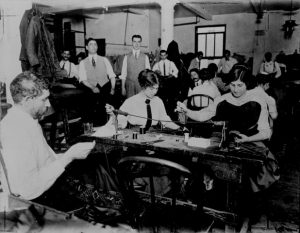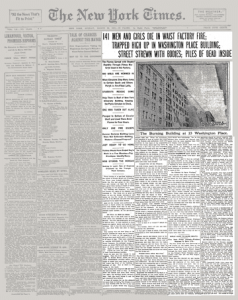“We didn’t have a chance….all of a sudden the fire was all around. The flames were coming in through many of the windows” -Rose Glantz, ninth floor operator, Triangle Shirtwaist Factory fire survivor.
On March 25, 1911 a fire erupted in New York’s East Village at the Triangle Shirtwaist Factory. One of the worst industrial disasters in modern United States history, the Triangle Shirtwaist Factory Fire claimed 146 victims in under eighteen minutes, most of whom were young Jewish and Italian women recently immigrated to the United States. Described by historian Richard A. Greenwald as a disaster that is “often invoked, but little understood,” the Triangle Shirtwaist Fire remains an infamous example of the brutal reality of industrialization in twentieth century American life.

The Triangle Shirtwaist Sweatshop
The Triangle Shirtwaist Factory, one of the many sweatshops in the city, was owned by Max Blanck and Isaac Harris and located on floors 8-10 of the Asch Building. Defined in 1994, the United States General Accounting Office (GAO) qualified a ‘sweatshop’ as a workplace that violates “more than one federal or state labor law governing minimum wage and overtime, child labor, industrial homework, occupational safety and health, workers compensation, or industry regulation” (Bender, 13). By this logic, the GAO retroactively estimated 2,000 of the 6,000 garment shops in New York City at the turn of the century to be sweatshops (though many believe this number to be much higher). Within the given parameters, the Triangle Shirtwaist Factory was a sweatshop, as it fulfilled almost all of the characteristics of worker exploitation: young, vulnerable work staff, long hours, dangerous and unsanitary conditions, and low pay (Bender, 13). During the hiring process, owners Blanck and Harris subcontracted individuals to hire the garment manufacturers, allowing their subcontractors to set the pay rates, and allowing the owners to avoid any responsibility for worker protections. On a given day, Blanck and Harris did not know who was walking into their factory, though they often hailed from the same demographic: young European immigrant women from Brooklyn who barely spoke English and were the main economic supporters of their families (Aitken, 54).

The Fire on the 8th and 10th Floors
Beginning at 4:45 PM on March 25, 1911, just as workers were finishing up their half shift for the day, a fire ignited on the eighth floor when a cigarette struck one of the many piles of fabric that had been accumulating under the work benches at Triangle. It soon engulfed the entire floor, quickly catching onto the newly finished shirtwaists hanging from the ceiling, as well as the unattended heaps of fabric, some supposedly six feet high, that were kept in “non-regulation, flammable wicker baskets” on the floor (Cornell University, ILR School). Despite the speed of the fire, workers on the eighth floor, such as Dinah Lifschitz, were able to effectively spread the word to the tenth floor, where the bosses worked (Stein, 37). Due to the ample warning, out of seventy tenth floor workers, all but one were able to escape the fire by traveling to the roof, where several New York University students next door, utilizing some ladders left by painters, guided the workers toward the school’s roof (Aitken, 54). While the majority of tenth floor workers and the bosses were able to escape up to the roof, eighth floor workers, in turn, piled onto the functioning passenger elevator, as well as out of the door that was eventually opened by employee Louie Brown, who had a key (Transcript, 1018).
As seen through personal accounts, more lives were saved than lost on the eighth and tenth floors of the Asch Building; the same cannot be said about the ninth floor, where the majority of the 146 deaths took place. After informing the tenth floor of the fire, Dinah Lifschitz made a call to the ninth floor, but received no answer; therefore, all ninth workers were caught off guard at the sight of the fire which swiftly filled up through the windows (Stein, 37, 54).
The Fire on The 9th Floor
According to Rose Glantz, one of the few ninth floor survivors, spirits were high on the floor as the young workers finished up for the day, dressing in the coat room near the Washington Place stairs. However, when the first group of workers finally left the dressing room, “giggling and happy,” the flames were breaking through the ninth floor windows and their “laughter turned to screams” (Stein, 37). Glantz ran to the Washington Street exit closest to her and found it to be locked. Due to Glantz’s quick reflexes, along with the fact that she was one of the first ninth floor workers made aware of the fire, she was able to run down the Greene Street staircase on the other side of the building before the flames completely engulfed it: “The fire was in the hall on the eighth floor. I pulled my scarf tighter around my head and ran right through it. It caught fire. I have a scar on my neck” (Stein, 37).
Considering the Washington Place exit was locked, as flames ultimately filled the Greene Street staircase, the only workable exit from the ninth floor, the remaining workers were left with only two options: die in the flames or jump from the ninth floor window to the pavement below. Sixty workers chose to jump from the building, crashing to the ground below where their corpses remained throughout the duration of the fire. Newspapers reported of the firefighters who, following the fire, found over fifty scorched bodies piled up against the locked ninth floor doorways (Stein 37). The New York Times front page the following day, March 26, 1911, reported on the damage: “141 [number later raised to 146] Men and Girls in Waist Factory Fire; Trapped High Up in Washington Place Building; Street Strewn with Bodies; Piles of Dead Inside.”

